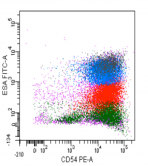
2015/07/15
Molecular processes affecting mammary luminal progenitor fate
In contrast to most mammalian organs, the mammary gland develops mostly after birth. Mammary epithelium is a bilayered structure formed by luminal and myoepithelial cells. Luminal cells are responsible for producing milk. When the mammary gland grows, new luminal cells develop from a subpopulation of luminal progenitor cells. Intriguingly, these progenitor cells are also thought to be the source of certain types of breast cancer.
A group at the Institute Curie in Paris, in collaboration with Maria dM Vivanco, a Group Leader at CIC bioGUNE, and researchers from the Karlsruhe Institute of Technology and Baylor College of Medicine in Houston, have found that paracrine Met signalling triggers epithelial-mesenchymal transition in mammary luminal progenitors, modulating their fate during mammary development and tumorigenesis. This work will contribute to better define the cell population that should be targeted by anti-cancer therapy.
This study has been published in the journal eLIFE.
See a large version of the first picture





